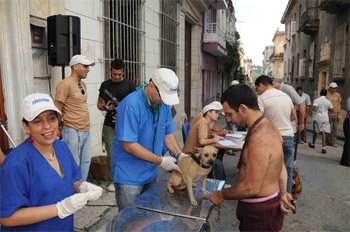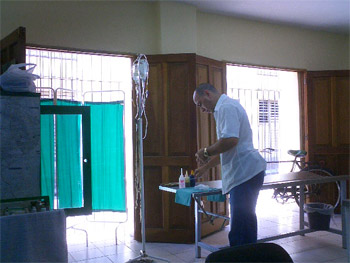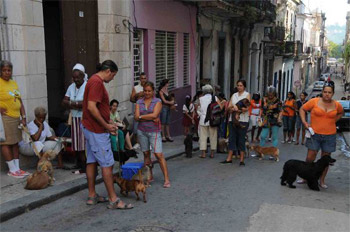Consolidating the Cuban Nation Will Take Centuries
By Veronica Vega

HAVANA TIMES — As I haven’t experienced the horrors of war, I can say that my worst impressions have been seeing animals abused and the absurd impunity for the abusers, against whom there are no laws here requiring punishment.
Even today, the absence of these laws in our criminal justice system — essential for any civilized nation — is a situation that remains intact in Cuba.
Despite this, what I want to talk about is what is done in support of animals, even in the heart of Old Havana, a place where overpopulation charges the environment with tension and cruelty.
I say this because I used to live there, and several experiences that I recall involving abuse were precisely in those streets.
At the Laika Veterinary Clinic, located a few blocks from the train station, Doctor Fernando Gispert (who is a veterinarian and a specialist in homeopathy and acupuncture) is the coordinator of several animal programs.
These include mass sterilization and deworming, interest meetings to raise the consciousness of children and adolescents with regard to animals, and a pet adoption program directed toward the elderly (who are then physically and psychologically supported in that special emotional relationship).
But Dr. Gispert himself reminds me that there are other essential players: people who are sensitive and not indifferent to the suffering of animals.

HT: Why did you become interested in veterinary medicine?
Fernando Gispert: Well, when I was a child I would watch television series like “Flipper” and the ones where doctors who would come on healing wild animals, you know. That became my fantasy. I wanted to be the savior, the hero. People criticized me a lot. I remember that even the principal at my school spoke to me because I was one of the best students, the kind he wanted to pursue college prep and then go on to something like medicine… But I all I wanted was to be a veterinarian.
But I was so impatient that I didn’t want to wait to study at the university. So I graduated from technical school in veterinary medicine, from the Camaguey Polytechnic.
HT: How did the idea of founding the Laika Clinic come about?
FG: It took years of effort to establish this clinic. The idea came from the Institute of Veterinary Medicine, but I didn’t have a suitable place. There wasn’t even anyone who could provide home care services. So I started it on a voluntary basis. We had a phone that people could call requesting vet services, but in the meantime we started looking for a place, with the support of Eusebio Leal, the head of the City Historian’s Office.
That support was very powerful, both for and against, since in our hurry to find a place sometimes we would identify one and the institute would want to renovate it itself. However the City Historian disagreed and convinced us that it didn’t offer ideal conditions.
Eusebio Leal has done some serious work and has earned a great amount of prestige, which is why people here in Old Havana love him. The place where the clinic is located now was previously a farmers’ market. Back then the Paula Street Market was developed with everything needed for that kind of operation, so the old farmers’ market facility (which had originally had been a pharmacy) became available – though it was practically falling down.

HT: What agency funded the renovation?
FG: The Institute of Veterinary Medicine, but Eusebio Leal provided a lot of support, including site managers from the Historian’s Office. I was lucky enough to get a release from my full time job so that I could be here full time. In that way I was able to structure the clinic like I wanted.
Between two bricklayers and myself, we constructed two new walls, and then came the electrical and waterline installation. There was a good energy between everyone who worked on that job. The clinic is located a few blocks from Merced Church and a few blocks from the birthplace home of Jose Marti, which for me isn’t something whose symbolism is by chance.
It was a big responsibility in every way, and although the clinic isn’t up to what we would like it to be, we try to keep it in as good a condition as possible.
HT: But right now Laika is in better shape than the Carlos III clinic, even though it’s older and has much more space.
FG: Yes, the Carlos III clinic is badly deteriorated, in part because of irresponsible people but also due to other factors. Socialist society has a function closely linked to protecting people but there are also major inefficiencies in its economic performance here.
I’m of the opinion that any business should have access to at least 1 percent of the profits that it produces for use on its own maintenance. The state might be willing to supply everything, but it doesn’t have the ability. Right now, for example, if we produce earnings of $20,000 pesos a month, we can’t even apply $100 pesos of that toward the purchase of a mop, floor cleaner or a little paint.

HT: Who supplies you?
FG: The Institute of Veterinary Medicine supplies us from what it purchases using the profits from its own products, from companies like BIOFAN, which produces very effective medicines. There are other companies but these deal in foreign currency, such as Bayer.
HT: But do you receive enough supplies?
FG: We get at least the most important vaccines, like ones that fight parvovirus, which is so disastrous. We’re not short on those, nor do we lack a leptospirosis medicine. But there are difficulties with distemper and hepatitis due to basic shortages we experience in producing vaccines against those ailments. So they get imported, though they’re very expensive.
But while these are diseases that devastate dogs, I’d say that they are also devastating to families, because having an animal that’s convulsing and foaming at the mouth is a very painful and traumatic experience.
The duration of these diseases is a terrible agony, and if the animal survives there are still ongoing effects. People get worn down in this process; they lose their ability to concentrate and stop performing well on their jobs or at school… You can’t look at an animal in isolation from its social context.
HT: Do you receive donations?

FG: Fortunately, and this is something we respect and value. We have a lot of control over our donations and we budget them as much as possible to keep our programs running. One of the key ones is sterilization, which may be selective or massive.
You see the clinic opened on February 2, 2002, and in May we waged our first sterilization campaign. But in 2006 we decided to form a sterilization team. This meant involving people who were willing to go around picking up stray animals and creating the conditions for them to be sterilized – which is a long-term solution to the problem of stray animals.
At the beginning it was tough, but the donations kept coming. People would show up crying in the office with a puppy they had found, and we would ask them if they were willing to support us. That’s how we created this group of twelve animal lovers here in Old Havana.
HT: Did they do that with their own resources?
FG: Yes, with their own resources. And I can testify that during the first two years they did everything. They picked up all of the animals, fed them and got rid of their parasites, paying the expenses out of their own pockets, because at that time we couldn’t offer them what the institute gives us now. In the commission are all kinds of people: intellectuals, engineers, artists, and ordinary people, like parking attendants, housewives and so on.
We’re all proud that at least in Old Havana there aren’t any strays. There are some street dogs wondering around, but they have owners, it’s just that we can’t convince them to sterilize those animals or make these individuals aware of the need to keep their animals inside the house.
HT: But aren’t there any laws that, for example, whereby a person can be fined for allowing their dog to roam the street or wonder around in heat?
FG: There are very minor laws, such as Law 181 of the Ministry of Agriculture, which provides for the protection of animals. Although it refers to larger animals such as cattle, it says that people cannot abuse an “animal,” but the fines are minimum…10 pesos or 5 pesos. Plus, there are very few veterinary inspectors.
HT: And there’s no penalty for bestiality, for example? Because I know a woman who picked up a dog that had been raped by a man.
FG: That’s horrible, it’s savage. I think there should be some kind of legislation, but you would have to ask an experienced attorney, because such cases are not common in any court.

We now want to lead some kind of campaign against dog fighting, which is also bestial. Those people who incite these animals to fight are more animal than their own dogs.
We’ve had some success with this, particularly at the clinic. People come in with dogs that were clearly used for fighting, though none of them will admit to being the pet’s owner, apparently those “belong to someone else” and they “just want to save them.”
There are cases in which we have attended them for free because the animal is in such terrible condition, and the people never have any money. Later I’ll talk with them and try to convince them not to stop putting their pets in dog fights.
HT: I remember a phrase that I heard you say, it was something like: “It takes centuries of civilization to achieve a consolidated nation.” Was that a quote from someone?
FG: No, it is a reflection of mine that explains a principle of anthropology: a nation needs to go through stages in its formation: inception, maturation and consolidation…even death. Today, many nations are known only from archaeological finds (the Balik Valley, Troy, Horites…)
The Eurasian nations were formed thousands of years ago, but we only have 400 years of civilization and only 150 years as a nation, within which we begin to mature around 1930, though we’re still not a consolidated nation.
Among some Cubans there are even annexationist tendencies, which is something that doesn’t help any country consolidate. Mature nations don’t feel the need to look like anyone else.
In developed countries, people love animals because when they’re born they’re ready for these creatures. If you look back 200 years you’ll see that they mistreated them just like we do today. But we have the opportunity to not have to go through the development steps that they went through; we can catalyze our social formation and skip steps. These days people are reluctant to try things. Do we still act like adolescents? You can give people a thousand tips and they’ll still do what they please.
HT: I’d like to ask you a last question. I’ve seen how horse-drawn coaches in Central Park are parked right out in the burning sun during the hottest times of the day while the drivers sit in the shade. One driver told me that they have specific places to park and if they park somewhere else they’ll get fined. Is this true? Doesn’t the law aim at the well-being and safety of these animals?
FG: No, unfortunately, there is no law in Cuba for animal welfare or animal protection. I don’t know if Cuba is even a signatory to the 1976 UN Charter on the Rights of Animals. The Aniplant animal rights organization hasn’t succeeded in making people aware of that international pact. Aniplant is an old organization, but it has lost a lot of its prestige due to corruption scandals and the misallocation of donations. Plus, its criticism of the government hasn’t helped much.

The Cuban Veterinary Science Council’s National Commission for Animal Welfare hasn’t achieved anything beyond what appears on paper and in front of TV cameras. Their achievements have been isolated and are due only to the efforts of sensitive individuals, such as famous artists, the Office of the Historian, local vets or people in a few provinces… but everything has been thanks to the efforts of isolated individuals.
Allowing the presence of horses in the historic center was a long battle won 20 years ago by the Office of the Historian, since animals weren’t allowed to be ridden or to supply urban areas. Those were regulations of the institute of Veterinary Medicine and of the city’s Traffic Department, one relating to traffic congestion and the other due to the problems of parasites, mites and animal odors.
The Historian’s Office won the battle in an exceptional way but the Traffic Department was the one responsible for locating the parking sites. At times of the day when the temperature is highest, there’s no shade for the coaches that park at San Francisco Plaza, Prado, or Cuba and Peña Pobre streets. But nearby — in the shade — sit the heartless coachmen. Good coachmen find other places to station their horses.
It seems they’re trying to eliminate horse-drawn carriages from the historic center, but that’s not the answer. We can have healthy and clean animals working while maintaining control over their feces and urine. There is one program — still at the stage of theory — to install water troughs and modern acrylic sun shades to cover those parking areas (they even existed in the 19th century). We’ll see who wins.
Click on the thumbnails below to view all the photos in this gallery. On your PC or laptop, you can use the directional arrows on the keyboard to move within the gallery. On cell phones use the keys on the screen.
























Very nice article.
A few points that need correction.
The photo titled “The clinic after the building was repaired.” is not Clinca Laika but a Consultorio in Barrio Santo Angel.
And under the heading “Who Supplies You” the company is not BIOFAN but the Cuba company LABIOFAM.
Dr.Gispert and the Sterilization Commission have done great work in reducing the stray population of Habana Vieja.
The Spanky Project supports them and is helping export that model to other parts of Havana.
We also provide deworming for the carriage horses several times per year.